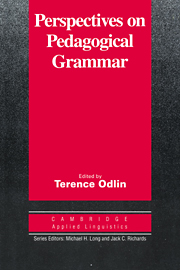Book contents
- Frontmatter
- Contents
- List of contributors
- Series editors' preface
- Preface
- Chapter 1 Introduction
- I WHAT SORT OF GRAMMAR?
- Chapter 2 Universal Grammar and the learning and teaching of second languages
- Chapter 3 Non-transformational theories of grammar: Implications for language teaching
- Chapter 4 Rules and pedagogical grammar
- II GRAMMAR, LEXICON, AND DISCOURSE
- III PUTTING GRAMMAR TO WORK
- Glossary
- Index
Chapter 3 - Non-transformational theories of grammar: Implications for language teaching
Published online by Cambridge University Press: 05 October 2012
- Frontmatter
- Contents
- List of contributors
- Series editors' preface
- Preface
- Chapter 1 Introduction
- I WHAT SORT OF GRAMMAR?
- Chapter 2 Universal Grammar and the learning and teaching of second languages
- Chapter 3 Non-transformational theories of grammar: Implications for language teaching
- Chapter 4 Rules and pedagogical grammar
- II GRAMMAR, LEXICON, AND DISCOURSE
- III PUTTING GRAMMAR TO WORK
- Glossary
- Index
Summary
Introduction
It is easy to be confused about the relationship between grammar theory and language teaching. Someone entering the language teaching profession at this time might reasonably expect that the results of decades of scientific study of language structure would have yielded some tangible results for teachers. Yet, if we look at the work of practicing teachers or read through the texts designed to teach language students something about the grammar of the language they are trying to learn, we find very little direct evidence of the influence of such theory. Contemporary texts teaching grammar, to the extent that they vary with traditional ones, have taken on instead notions from theories of acquisition and processing, focusing on the importance of meaningful and contextualized practice. The rules used to describe the language structures themselves, however, remain to a large degree unchanged from the form of traditional grammars, and where rules have been changed, the source of the change has often come from language teachers themselves rather than from theoretical linguists.
Linguistic theory has, of course, been directly applied in language teaching in the past. Audio-lingual texts and structural grammars attempted to take the sentence patterns from structural linguistic analyses and drill them into the students through pattern practice. Transformational grammar, too, was directly applied in the 1960s and early 1970s. The lack of success with these applications led to the idea that even if rule formulations from linguistic theory were not directly useful to the student, perhaps they were still useful to the teacher in writing grammarbased exercises, understanding and responding to student questions about structures, and dealing with learner errors.
- Type
- Chapter
- Information
- Perspectives on Pedagogical Grammar , pp. 49 - 71Publisher: Cambridge University PressPrint publication year: 1994
- 9
- Cited by



